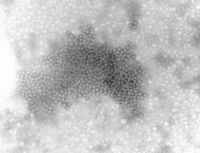Parvoviridae
A Viral Biorealm page on the Parvoviridae

Baltimore Classification
Higher order taxa
Virus; ssDNA viruses; Parvoviridae
Genera
- Densovirinae (subfamily)
- Brevidensovirus
- Densovirus
- Iteravirus
- Pefudensovirus
- three unclassified Densovirinae
- Parvovirinae (subfamily)
- Amdovirus
- Bocavirus
- Dependovirus
- Erythrovirus
- Parvovirus
- two unclassified Parvovirinae
Description and Significance
Parvoviruses are significant pathogens in the veterinary sciences. These viruses are particularly associated with reproductive failure. A variety of host species are infected by the 3 genera encompassed by the Parvoviridae family. Parvoviruses are among the smallest, simplest eukaryotic viruses and were only discovered in the 1960s while human parvovirus infections were only recognised in the 1980s. They are naked icosahedral viruses with a genome of a single-strand DNA. The desonucleosis viruses infect insects while the dependoviruses require a helper virus for replication. Although they have been described in a number of mammalian species including man, they are yet to be linked to any disease. The third genus consist of autonomously replicating parvoviruses which are frequently associated with diseases.
Parvovirus B19 is the only parvovirus that has been linked directly to disease in humans. The virus is resistant to heat, cold and solvents. The virus can lead to subclinical infection, dermatologic involvement, such as erythema infectiosum, hematologic findings such as transient aplastic crisis or chronic anemia in the immunocompromised host, rheumatologic manifestations such as arthritis, and even life-threatening effects such as hydrops fetalis.
The B19 virus was discovered by Cossart in 1975 while investigating hepatitis B virus laboratory essays. The name B19 came from the blood bank code by which the original positive serum sample was labeled. The positive serum was number 19 in row B of a panel of sera.
Genome Structure
The genome is not segmented and contains a single molecule of linear, negative-sense, single-stranded DNA in most mature virions, or of linear, negative-sense and positive-sense single-stranded DNA in up to 50% in some members. The complete genome has terminally redundant sequences, is repeated at both ends and 5000 nucleotides long. Nucleuotide sequences at the 3'-terminus are complementary to similar regions on the 5' end, or unrelated to the 5'-terminus. The 5'-terminus sequence has palindromic repeats, forming a hairpin structure; terminal repeats at the 5'-end are 200-242 nucleotides long. The 3'-terminus has conserved nucleotide sequences; of 115-116 nucleotides in length; in species of same genus; sequence has hairpin structure. Populations of mature viruses contain particles with equivalent numbers of positive and negative sense ssDNA. The complementary DNA strands usually form dsDNA upon extraction. (source: ICTV dB Descriptions)
Virion Structure of a Parvovirus
The virions of a parpovirus consist of a capsid that is not enveloped but round with icosahedral symmetry. The nucleocapsid is isometric and has a diameter of 20-26 nm. The capsid consists of 60 capsomers. Each capsomer is a quadrilateral 'kite-shaped' wedge. The surface projections are small, the surface appears rough and there are distinct spikes. (source: ICTV dB Descriptions)
Reproductive Cycle of a Parvovirus H-1 in a Host Cell
The replication of the single-stranded DNA parvovirus H-1 involves the synthesis of a double-stranded DNA replicative form (RF). The initiation of RF DNA replication occurs late in the S phase, and so is the synthesis of the DNA upon which subsequent viral hemagglutinin synthesis is dependent. There has been evidence to suggest that initiation of RF replication requires proteins syntesized in late S phase, but the concomittant protein synthesis is not required for the continuation of RF replication. There is also evidence of a requirement for viral proteins for progeny strand synthesis. Various tests have been carried out to show that parental RF DNA is synthesized shortly after infection and that viral mRNA is transcribed from only a few copies of the viral genome in each cell. Vital protein is a lso inhibitory to RF DNA replication.
Viral Ecology & Pathology
The B19 virus is present throughout the year. In temparate climates, outbreaks of infection are more common in the spring and summer. Primary schools are the major targets, where up to 40% of pupils may get infected. 4-10 year olds are most susceptible to infection. 60% of the population are seropositive by adulthood. The usual route of transmission of the virus is respiratory spread. 1 in 40000 blood donations have virus present and bloodborne spread can occur in recipients of whole blood and factor VIII. Haemophiliac children have a significantly higher frequency of seropositivity than is normal.
The B19 virus has been associated with erythema infectiosum, aplastic crisis in patients with chronic haemolytic anaemias, fetal loss in pregnancy and persistent infection in immunocompromised patients. Evidence suporting the presence of B19 in human diseases has already been found. The virus sets up a systemic infection with copious viraemia one week after innoculation. The virus is shed from the respiratory tract at the same time. IgM appears as the viral titres fall and there is a delay of several days before IgG appears.
Reticulocyte members fall to undetectable numbers during viraemia but recover 7 to 10 days later. Normal people lose 1g of Hb. Lymphopenia, neutropenia and thrombocytopenia also occur. The rash appears 17-18 days after innoculation and arthralgia a day or so later: the erythema infectiosum symptoms occur relatively late. These symptoms are likely to be immune mediated. It appears that an early erythrocyte precursor is susceptible to B19 infection. (sources: Virology-Online)
References
Janet Vafaie,MD, and Robert A. Schwartz,MD, MPH; "Parvovirus B19 Infections"; International Journal of Dermatology 2004, 43, 747–749
Solon L. Rhode III, "Replication Process of the Parvovirus H-1 III. Factors Affecting H-1 RF DNA Synthesis"; Journal of Virology
